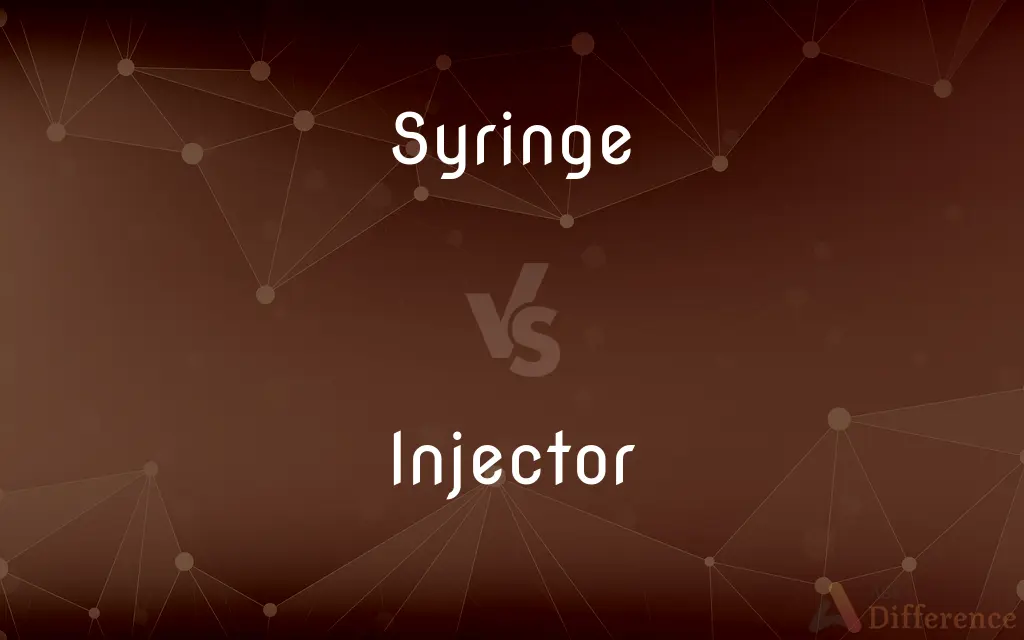Syringe vs. Injector — What's the Difference?
By Fiza Rafique & Urooj Arif — Updated on April 20, 2024
A syringe is a medical device for injecting fluids into or withdrawing them from something, typically using a plunger; an injector, on the other hand, refers to a device or mechanism that introduces a substance into something else, often under pressure.

Difference Between Syringe and Injector
Table of Contents
ADVERTISEMENT
Key Differences
A syringe, typically made of a plastic or glass cylinder with a plunger that fits snugly within, is used for drawing in and ejecting liquid through a needle or tubing. Whereas, an injector may not involve a manual plunger but uses pressurized mechanisms to deliver substances, often in contexts like fuel systems or medical drug delivery systems.
Syringes are commonly used in medical settings for the administration of injections, vaccinations, and for drawing blood. On the other hand, injectors can be found in both medical devices, such as auto-injectors for allergies, and in mechanical applications like fuel injectors in vehicles.
The design of a syringe allows for precise control over the volume of fluid drawn or injected, thanks to the gradations marked on its body. Whereas injectors, especially in medical applications like insulin pens, often come pre-loaded and are designed for ease of use, sometimes without detailed dosage control.
Syringes require manual operation to either draw in or expel fluids, relying heavily on human control for accuracy. Injectors, however, can be automated or semi-automated devices that deliver a preset amount of substance with minimal human intervention.
While syringes are reusable or disposable, designed for general use across various medical applications, injectors are often specifically designed for particular types of drugs or uses and might be single-use, especially in the case of emergency medical devices like epinephrine pens.
ADVERTISEMENT
Comparison Chart
Mechanism
Manual plunger
Pressurized or mechanical
Usage
Medical injections, drawing blood
Medical and mechanical applications
Control
Manual, precise dosage control
Often automatic, fixed dosage
Reusability
Reusable and disposable types
Often single-use
Common Types
Plastic, glass
Auto-injectors, fuel injectors
Compare with Definitions
Syringe
A device used to inject fluids into or withdraw them from the body.
The nurse used a syringe to administer the vaccine.
Injector
Used in medical devices like insulin pens and epinephrine pens.
Her injector was always on hand in case of an allergic reaction.
Syringe
A tool in medical research for measuring and transferring liquids.
He filled the syringe with the solution to prepare the sample.
Injector
Can refer to parts in engines that introduce fuel into the combustion chamber.
The vehicle's performance improved after cleaning the injectors.
Syringe
A simple pump consisting of a plunger that fits tightly in a tube.
The syringe was sterilized before being used.
Injector
A device for forcing a liquid or gas into an object.
The mechanic checked the fuel injector for clogs.
Syringe
Often made of plastic or glass, marked with measurements.
The doctor checked the medication volume in the syringe.
Injector
Often incorporates a mechanism for automatic or pressurized delivery.
The injector delivered the correct amount of fuel to the engine.
Syringe
Can be equipped with a needle for injections.
The syringe needle was very fine to minimize discomfort.
Injector
Typically more specialized than a syringe.
Each injector is designed for a specific type of medication.
Syringe
A syringe is a simple reciprocating pump consisting of a plunger (though in modern syringes, it is actually a piston) that fits tightly within a cylindrical tube called a barrel. The plunger can be linearly pulled and pushed along the inside of the tube, allowing the syringe to take in and expel liquid or gas through a discharge orifice at the front (open) end of the tube.
Injector
An injector is a system of ducting and nozzles used to direct the flow of a high-pressure fluid in such a way that a lower pressure fluid is entrained in the jet and carried through a duct to a region of higher pressure. It is a fluid-dynamic pump with no moving parts, excepting a valve to control inlet flow.
Syringe
A medical instrument used to inject fluids into the body or draw them from it.
Injector
To force or drive (a fluid) into something
Inject fuel into an engine cylinder.
Inject air into a liquid mixture.
Syringe
A hypodermic syringe.
Injector
To introduce (a drug or vaccine, for example) into a body part, especially by means of a syringe.
Syringe
A device used for injecting or drawing fluids through a membrane.
Injector
To treat by means of injection
Injected the patient with digitalis.
Syringe
A device consisting of a hypodermic needle, a chamber for containing liquids, and a piston for applying pressure (to inject) or reducing pressure (to draw); a hypodermic syringe.
Injector
To introduce into conversation or consideration
Tried to inject a note of humor into the negotiations.
Syringe
To clean or rinse by means of a syringe.
Have your ears syringed! They're so dirty!
Injector
To place into circulation
Inject money into the economy.
Syringe
To inject by means of a syringe.
Injector
To place into an orbit or trajectory
Inject a satellite into geosynchronous orbit.
Syringe
A kind of small hand-pump for throwing a stream of liquid, or for purposes of aspiration. It consists of a small cylindrical barrel and piston, or a bulb of soft elastic material, with or without valves, and with a nozzle which is sometimes at the end of a flexible tube; - used for injecting animal bodies, cleansing wounds, etc.
Injector
(Physics) To cause (a beam of particles, for example) to strike a target.
Syringe
To inject by means of a syringe; as, to syringe warm water into a vein.
Injector
One who, or that which, injects something.
Syringe
To wash and clean by injection from a syringe.
Injector
One who injects (himself or herself with) psychoactive drugs.
Syringe
A medical instrument used to inject or withdraw fluids
Injector
Any of various devices that are used to inject something.
Syringe
Spray or irrigate (a body part) with a syringe
Injector
(object-oriented programming) An object that realizes a dependency injection.
Injector
One who, or that which, injects.
Injector
A contrivance for forcing feed water into a steam boiler by the direct action of the steam upon the water. The water is driven into the boiler by the impulse of a jet of the steam which becomes condensed as soon as it strikes the stream of cold water it impels; - also called Giffard's injector, from the inventor.
Injector
A contrivance for injecting (e.g., water into the boiler of a steam engine or particles into an accelerator etc.)
Common Curiosities
What are examples of injectors in non-medical settings?
Fuel injectors in vehicles are common examples of injectors used outside of medical contexts.
How do injectors differ from syringes in terms of operation?
Injectors often operate automatically or under pressure, providing easier and faster delivery than manual syringes.
Are injectors safe for personal use without professional supervision?
Many injectors, such as auto-injectors for allergies or diabetes, are designed for personal use with proper instruction and precautions.
What materials are syringes made from?
Syringes are usually made from plastic or glass.
What is the primary use of a syringe?
Syringes are primarily used for medical purposes, including injecting medications and drawing blood.
Can injectors be manually controlled?
Some injectors allow for manual control, but many are designed for fixed, automatic operation.
Is training required to use a syringe correctly?
Proper training is recommended to use syringes safely, particularly in medical settings.
Can syringes be reused?
Some syringes are designed to be reusable, while others are disposable for one-time use only.
What features make an injector user-friendly?
Features like pre-loaded medication, easy-to-use buttons, and clear instructions make injectors user-friendly.
How do I dispose of a used syringe safely?
Used syringes should be placed in designated sharps disposal containers to prevent needle-stick injuries and contamination.
What type of injector is commonly used in emergency medical situations?
Auto-injectors, such as epinephrine pens for treating allergic reactions, are commonly used in emergencies.
What makes injectors suitable for delivering precise doses of medication?
Injectors are often pre-calibrated to deliver exact doses, reducing the risk of dosing errors.
How are injectors adapted for use in automotive engines?
In automotive engines, injectors are designed to spray fuel directly into the combustion chamber, optimizing fuel efficiency and engine performance.
What is the significance of dosage control in syringes?
Dosage control is crucial in syringes to ensure the correct amount of medication or fluid is administered.
What should be considered when choosing between a syringe and an injector?
Consider the application, necessary precision, ease of use, and whether the device needs to be reused.
Share Your Discovery

Previous Comparison
Coordinator vs. Advisor
Next Comparison
Decline vs. DenyAuthor Spotlight
Written by
Fiza RafiqueFiza Rafique is a skilled content writer at AskDifference.com, where she meticulously refines and enhances written pieces. Drawing from her vast editorial expertise, Fiza ensures clarity, accuracy, and precision in every article. Passionate about language, she continually seeks to elevate the quality of content for readers worldwide.
Co-written by
Urooj ArifUrooj is a skilled content writer at Ask Difference, known for her exceptional ability to simplify complex topics into engaging and informative content. With a passion for research and a flair for clear, concise writing, she consistently delivers articles that resonate with our diverse audience.
















































